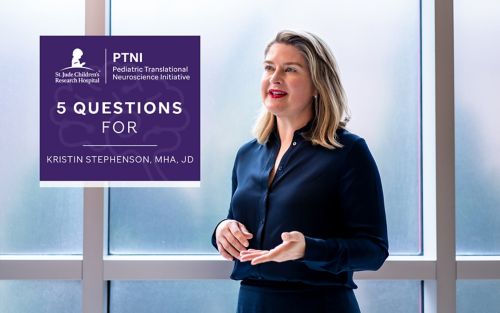St. Jude Family of Websites
Explore our cutting edge research, world-class patient care, career opportunities and more.
St. Jude Children's Research Hospital Home

- Fundraising
St. Jude Family of Websites
Explore our cutting edge research, world-class patient care, career opportunities and more.
St. Jude Children's Research Hospital Home

- Fundraising
5 Questions for Kristin Stephenson, MHA, JD

Kristin Stephenson, MHA, JD, has developed the Office of Strategy & Alliances to bridge the research and clinical endeavors of the Pediatric Translational Neuroscience Initiative with internal and external stakeholders.
This question-and-answer series explores St. Jude investigators’ origins, goals and accomplishments. Kristin Stephenson, MHA, JD, joined St. Jude Children’s Research Hospital to lead the Office of Strategy & Alliances (OSA) within the Pediatric Translational Neuroscience Initiative (PTNI) in 2021. Her background is in health care administration and law and has experience working with patient advocacy groups.
Stephenson’s broad experience makes her a natural fit to bridge the fundamental research of the Center for Pediatric Neurological Disease Research (CPNDR) and the clinical endeavors of the Center for Experimental Neurotherapeutics (CENT) with a growing panel of internal and external stakeholders engaged with the PTNI. Through her leadership, the OSA is setting the standard for strategy coordination and partner engagement.
1. What were the driving factors that brought you to St. Jude?
The opportunity to be part of something as exciting and bold as PTNI was something I could not pass up. The draw of the leadership and talent at St. Jude, along with the mission and the vision, was compelling. It felt like having the opportunity to work in a start-up within a sophisticated, well-respected institution with a proven track record. I did not anticipate ever leaving the East Coast, but I have not once looked back.
Early in my career, my exposure to healthcare was through the administrative side of hospitals and health systems and practicing healthcare law. At the time, I knew I wanted to be involved in healthcare and ideally in research, but at that point I hadn't had an opportunity to work directly with the community of researchers, practitioners, and patients and families. Since I was not a clinician or a scientist, I looked toward organizations directly supporting research and advocated for national policies to advance research.
I joined the Muscular Dystrophy Association and served as the executive lead of their national clinical network and their policy and advocacy department, which is the role I was in when I first became acquainted with St. Jude and with Dr. [J. Paul] Taylor [Executive Vice President, Scientific Director, Chair of the Department of Cell and Molecular Biology and Director of PTNI].
Dr. Taylor hosted a workshop in 2018 when he was exploring what a translational neuroscience program might look like at St. Jude. He invited people from around the country with different areas of expertise to share their research, experiences and impressions. It was exciting, and I left the workshop hopeful that St. Jude would step into this space and intrigued about what a St. Jude neuroscience effort would look like. Dr. Taylor and I kept a line of communication open, and ultimately, we started to discuss PTNI and his vision for having a formal function to engage external stakeholders such as industry, which was the premise for what is now the Office of Strategy and Alliances.
2. What was OSA set up to accomplish, and how has it grown since those formative years?
When the office was starting, we focused on developing alliances with external stakeholders, which we organized into four categories: industry, patient advocacy organizations and patient foundations, other institutions and researchers, and policymakers and regulators.
Over time, our focus has organically evolved and expanded to meet the needs of a growing PTNI. Through this process, the internal functions of OSA have become more apparent. OSA works closely with CENT and CPNDR to ensure strategic alignment across PTNI to achieve the greatest impact while using our resources as efficiently as possible. We have also developed synergies and communication flows between PTNI and key departments across the institution, including Legal, Innovation and Industry Engagement and the Office of Technology Licensing, Strategic Communication, Education & Outreach, the Strategic Planning Office, Clinical Trials Office, the GMP, and Government Relations, among others.
We also engage faculty and staff across St. Jude in the PTNI mission through programming and support mechanisms. For example, PTNI hosts workshops that bring in internal and external stakeholders. PTNI also launched a new fellowship program this year, and we’ve just announced our new PTNI grant program.
One of OSA’s primary functions internally is leading coordination efforts within PTNI. OSA works closely with CENT and CPDNR, and together, we have made great strides so far. Operating as a seamless team is a commitment that OSA, CENT and CPNDR share, and it allows us to accomplish more than would be possible if we worked as separate units.
3. What makes St. Jude uniquely positioned to facilitate the Pediatric Translational Neuroscience Initiative?
St. Jude has the courage, the expertise and the infrastructure to move the needle in pediatric translational neuroscience research and treatment. These capabilities and resources, in combination with Dr. Taylor’s vision, make St. Jude uniquely positioned to lead in this space. The design and function of PTNI is a great example – deliberate and thoughtful development yielded a functional design that drives translation by wedding bench and clinical research through a formal connecting mechanism, OSA. This approach has resulted in a highly functional framework that remains open and flexible enough that we can evolve and, importantly, scale.
4. What is the importance of external relationships to something like PTNI?
By working with external stakeholders, we can amplify and accelerate our work. For example, we may collaborate with a clinical expert on a disease at another institution to identify meaningful clinical measurements, we may work with a company or another academic lab on a preclinical concept or to leverage a technology.
Often, we work with a combination of stakeholders on a disease program since each provides unique insights and expertise. For example, we work with patient advocacy organizations to understand the patient’s voice and to learn how the organization and its connections to the community may help address current research gaps, particularly with clinical trial readiness.
5. What ways do you see OSA growing to facilitate the evolution of PTNI?
The key is in the way CPNDR, CENT and OSA work together. PTNI can best achieve its objectives when all our functions are aligned and actively engaged with one another. The more we do together, the better we get at it. And as our teams are growing, it's exciting because we're seeing this organic integration. Ultimately, OSA will grow and evolve as is best needed to suit the evolution and expansion of PTNI.
One area that we're looking closely at is how we may help shape national policies and regulations that impact pediatric neuroscience research. St. Jude is poised to have a meaningful role in this type of effort, as we have in other areas, including cancer research. We are excited to be working closely with our government relations team internally and directly with policymakers and regulators externally on these issues.
Whether we are working with internal or external stakeholders, what we have found is that engaging a broad spectrum of perspectives in transparent conversation is essential to advancing research and the development of treatments in the PTNI space. As opportunities arise, and we take on new initiatives, having ongoing dialogue and information exchange will be vital. We are ramping up holistically on what we can do now and in the future.







